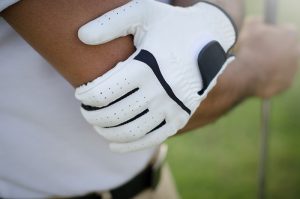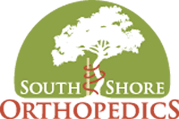
What is Golfer’s Elbow?
Golfer’s elbow is a common name for a medical term medial epicondylitis, a painful condition that occurs from repeated muscle contractions in the forearm that leads to inflammation and micro-tears in the tendons that attach to the medial epicondyle.
The medial epicondyle is located at one end of the humerus, the long bone of the upper arm. Its bony prominence is felt on the inside of the elbow.
Golfer’s elbow is similar to another overuse related condition commonly called tennis elbow. Though both conditions are a type of tendonitis, they differ in that golfer’s elbow occurs on the inside of the elbow whereas tennis elbow occurs on the outside.
Why is it called Golfer’s Elbow?
This condition is termed “golfer’s elbow” because it is commonly seen at the elbow of the bottom hand in a golf swing due to the stretch of the flexor muscles and the pull of the tendons at their insertion. If their flexor group is unable to adequately absorb the shock of this force, the weakest point becomes damaged and often inflamed. The same repetitive motion that contributes to golfer’s elbow may also occur with other activities such as painting, hammering typing, gardening, and other lawn care related tasks like raking and shoveling.
What are the symptoms?
Golfer’s elbow will often present with pain and stiffness at the inside of the elbow. As it progresses, inflammation may become present and manifest with warmth and swelling in the area around the medial epicondyle. This inflammation may compress on the ulnar nerve, which runs just behind the bony prominence. When this occurs, it is not uncommon for individuals to experience numbness and tingling down into the ring and pinky fingers.
Other common signs and symptoms include:
- Elbow pain that may appear suddenly or gradually
- Decreased range of motion
- Weakened grip
- Pain that worsens when gripping objects
- Elbow pain that worsens when the wrist is flexed or bent toward the forearm
How is Golfer’s Elbow Diagnosed?
For proper diagnosis, patients that suspect golfer’s elbow or are experiencing any kind of chronic elbow pain should be evaluated by an orthopedic specialist. This evaluation will include a discussion of your medical history and physical examination. Imaging such as an X-ray may be needed to rule other potential causes of your pain such as a fracture or arthritis.
In some cases, further tests may be needed to confirm golfer’s elbow such as an MRI, ultrasound or injection test.
How is it treated?
At South Shore Orthopedics, we focus on conservative care to treat golfer’s elbow and other elbow pain conditions so that surgery can be avoided when possible. In most instances, our surgeons will recommend anti-inflammatory medications, antibiotics for any infections, elbow wraps or elbow pads, avoiding activities that irritate the affected area, and physical therapy. If non-invasive measures prove to be ineffective, surgery may be recommended.
If persistent elbow pain is preventing you from living your life to the fullest, call (781) 337-5555 to schedule an appointment with South Shore Orthopedics. Our providers will identify the root cause of your pain and design a personalized treatment plan to give you the relief that you deserve.
